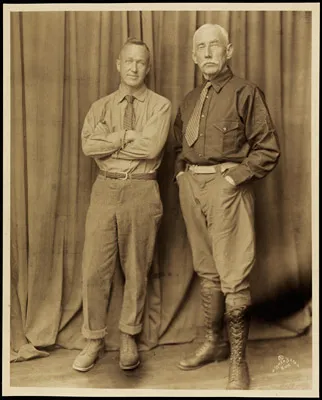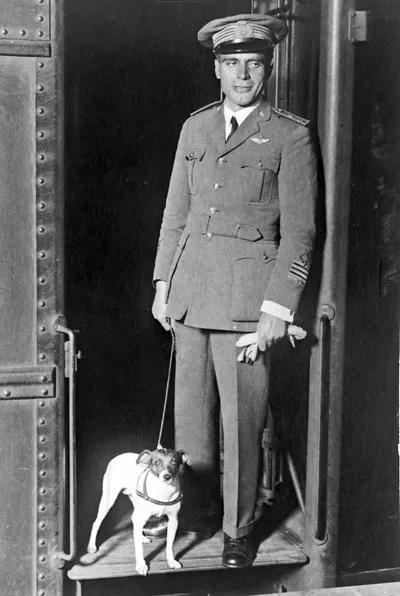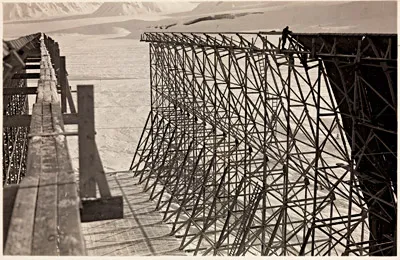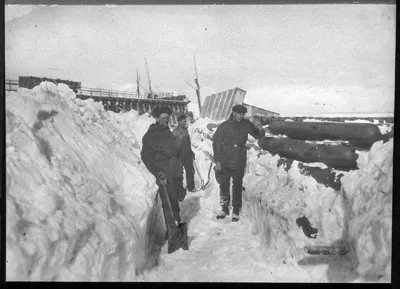
Roald Amundsen - 5
North Pole to Alaska by Airship, Norge - 1926
1 - Belgica,
Belgian Antarctic Expedition,
1897 - 1899 - 1st Mate
& Gjoa,
Northwest Passage, 1903-06
- Captain
2 - Fram,
South Pole Expedition,
1911-12 - Expedition Leader
3 - Maud,
Northeast Passage, 1918-25
- Expedition Leader
4 - N24 and
N25 Flying Boats,
North Pole
by Air, 1925
5 - Airship Norge,
North
Pole by Air, 1926
6 - The last years
and last journey to
1928
Roald Engelbregt Gravning Amundsen - 16th July 1872 - 18th June 1928
Film of the expedition on the Norge 3 mins 7 secs
While he was clearing a runway on the sea-ice to get back to safety with the N25 flying boat, Lincoln Ellsworth's father had died (June 1925) and left him a huge inheritance, easily enough to pay for any number of expeditions. By July Ellsworth, Amundsen and pilot Riiser-Larsen had met with Italian Umberto Nobile to purchase for $100,000, a second hand airship he had designed. Nobile was a senior officer in the Italian Military Air service and Benito Mussolini was at the time the prime minister of Italy and so was involved in the negotiations. Amundsen was offered use of the airship for free at his first meeting with Nobile in Norway if the expedition would fly under the Italian flag, it was an offer he refused, though Nobile would come along on the flight.
In August 1925 in Nome Alaska, the Maud arrived where she was seized and sold to pay off Amundsen's debts as part of his bankruptcy proceedings. An ignominious end to an expedition that yielded Amundsen had tired with some time beforehand.
The Airship Norge Flight Across the North Pole to Alaska, 1926
By October 1925 Amundsen was back in New York to generate publicity and raise money for his new venture to use the airship to investigate the wider Arctic region and fly over the North Pole on the way from King's Bay, Spitsbergen to Nome, Alaska leaving in May the following year, 1926.
He delivered his ideas and plans to the press who were as happy for a story as he was for the publicity, of possible undiscovered landmasses in the Arctic Ocean, perhaps even a continent, and the future of airship travel especially in polar regions where they could land and take off far more easily and reliably than other aircraft as they didn't require a large prepared smooth runway, he was to find that this latter idea was flawed because of the particular difficulties and requirements of airships that didn't apply to airplanes.
Meanwhile, the organization behind the expedition was getting increasingly more complex and confused, there was rivalry between Ellsworth and Nobile as to who would be named as co-leader and other personal and national agendas began to interfere with who was involved in what capacity and how things would be run. In particular it became clear that the airship wasn't being purchased from Nobile as an individual as appeared at first, but from the Italian state, Mussolini saw it as a great opportunity for publicity and there was pressure to increase the Italian participation beyond simply selling the airship. Rather than the flight addressing Ellsworth's and Amundsen's personal goals, there was a danger it may become a Fascist propaganda event. There were squabbles about who would write the official record of the adventure, about how many Norwegian and how many Italian crew there would be and how much clothing and luggage each man was allowed to take. The latter being under the control of Nobile who when it came to loading ready for the flight had been far more generous to the Italians than to the Norwegians.
Eventually it was settled that the airship would be called the "Norge" and would fly the Norwegian flag, though on the day of hand over in March by Mussolini in a field at Rome airport, the original designation N1 and some Italian colours were still in place.

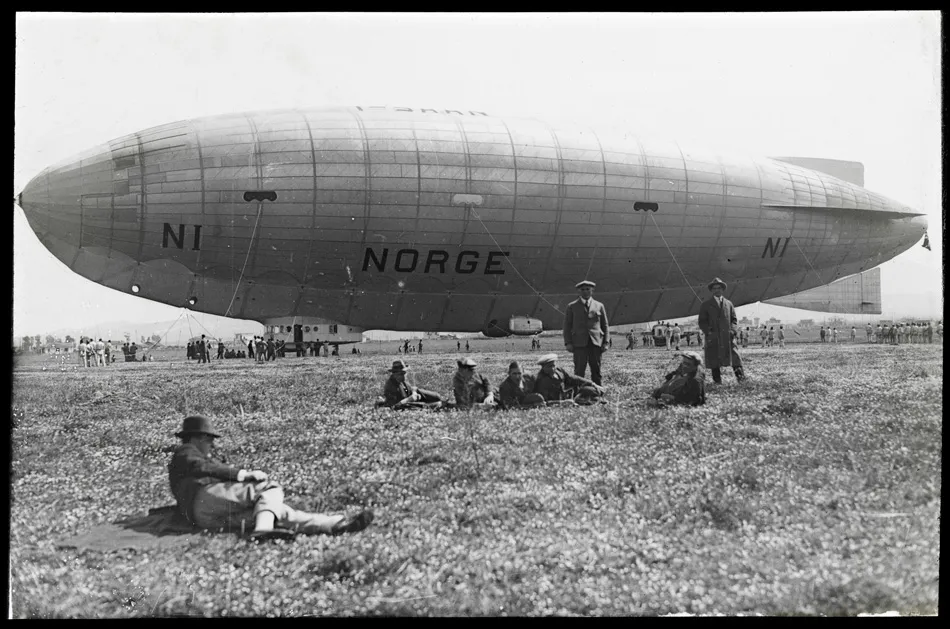
29th of March 1926, Rome airport.
top - Mussolini with members of the military at the handing-over
ceremony.
bottom - The airship taken out of the hangar.
Since
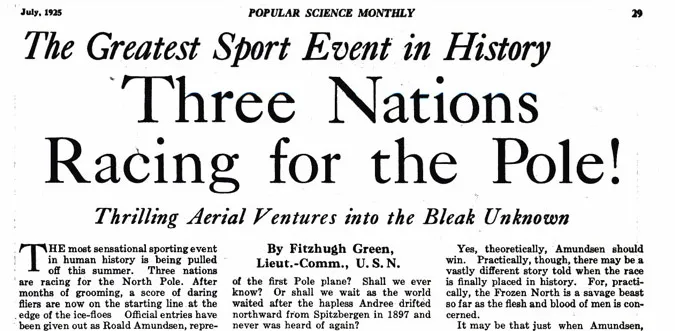 Amundsen
himself had begun to open up the Arctic to aviation, other explorers
and adventurers became similarly interested in discovering new
lands and trying to be the ones to achieve various "Firsts".
Amundsen
himself had begun to open up the Arctic to aviation, other explorers
and adventurers became similarly interested in discovering new
lands and trying to be the ones to achieve various "Firsts".
By the time the Norge was ready for its flight there were two more teams of aviators vying for publicity for similar events and the tiny mining settlement of King's Bay (now Ny Alesund) on Spitsbergen became a temporary home to reporters from Europe and America to cover the proceedings.
American Richard Byrd led an expedition of fifty men with two Fokker Trimotor airplanes to try and follow the route that Amundsen and Ellsworth had tried the previous year to the North Pole and back. Over in Barrow Alaska, George Wilkins was preparing to attempt to fly from there to the North Pole and back again or possibly on towards Spitsbergen. While each had different methods and specific goals, they were all attempting in some way to "conquer" the Arctic and discover new lands that may be in the vicinity of the pole leading to rivalries and suspicions between the different groups. These suspicions were exacerbated by the fact that in King's Bay Amundsen and Byrd had each sold the exclusive rights to their stories to different newspapers while each of these and other sets of reporters were trying to find out what they could by other means.
On the 7th of May 1926, the Norge arrived, having flown from Italy and was guided into its hangar, 30m high and 110m long which had been built from a timber frame on three sides faced with canvas for protection against the elements, particularly the wind.
There was rivalry at King's Bay between Amundsen's and Byrd's teams though this resolved to a degree of friendship between individuals at least with Byrd being given equipment such as snowshoes and warm boots and advice on runway selection and the best ice conditions for take off. Most of all perhaps, stronger skis for Byrd's trimotor the "Josephine Ford" were made by a member of the rival team after two had cracked in a test flight.
On May the 8th around midnight, Byrd took off for the pole returning some fifteen and a half hours later, several hours before he was expected. He was heralded for achievement of reaching the pole though later on it was calculated that he could not possibly have done so given his speed and journey time.
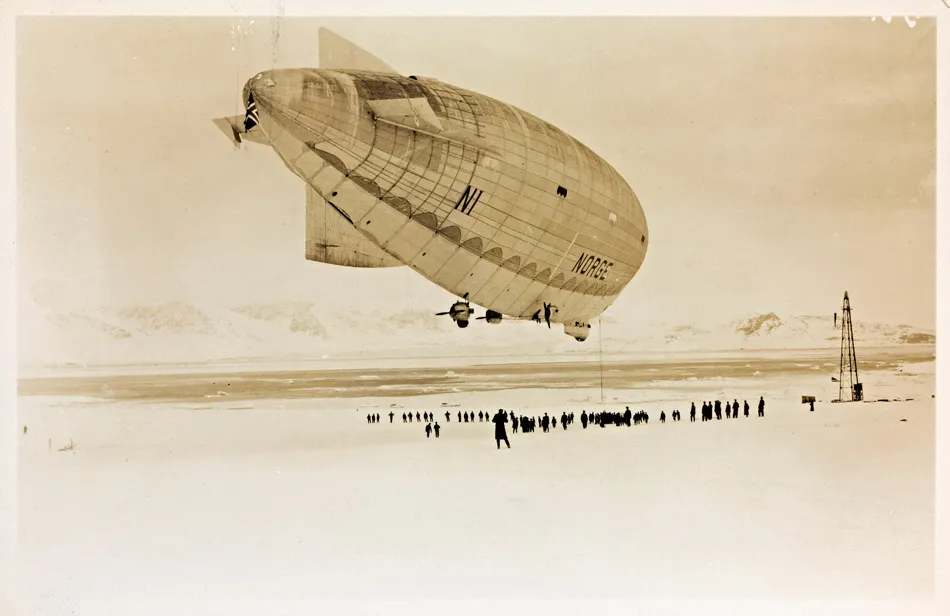
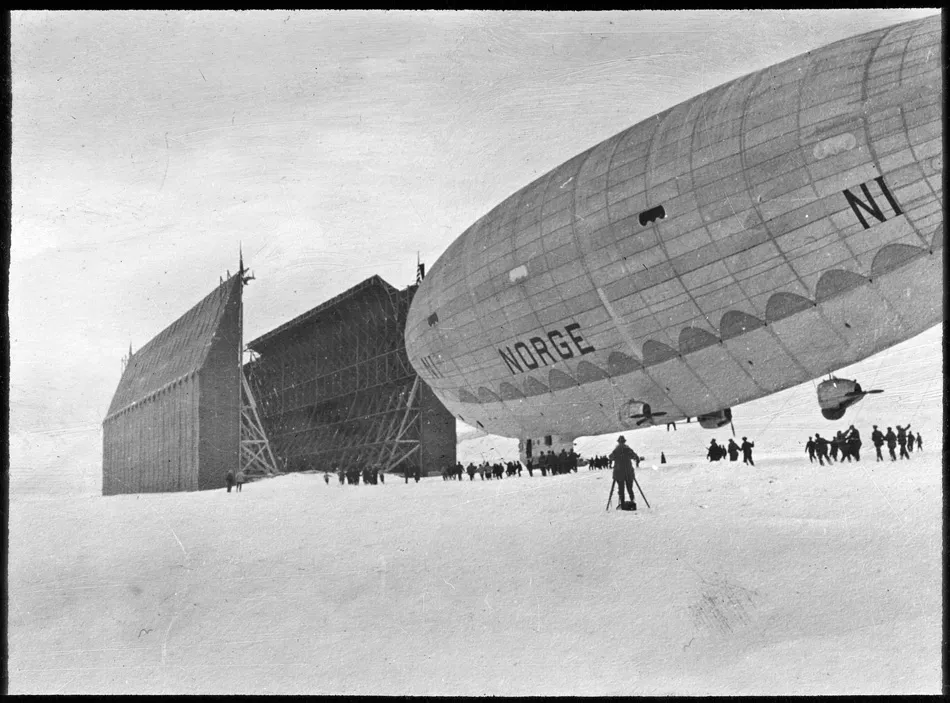
7th May 1926, the Norge arrives from
Italy and is guided into the hangar
By the 11th of May, Nobile decided it was ready to fly the Norge, a flight that would take place at 1 a.m. at the coldest time of day with the greatest lift from the denser cold surrounding air. Dozens of men on ropes pulled the airship out of its hangar though Amundsen, Ellsworth and the Norwegians didn't arrive until hours later causing Nobile to have to let off gas three times as it expanded with rising temperatures.
Amundsen though enthusiastic for airships did not really appreciate the specific problems of operating such a craft being attracted to them because of their take-off and landing abilities without the need for a large carefully prepared strip for conventional planes.
Flying such giant hydrogen filled airships was a balancing act between lift from the gas and weight from ballast and payload. When the gas warmed up with the ambient temperature or from direct sunlight, it expanded and made the vessel more buoyant, this could lead to the gas expansion bursting the gas bags (the airship has an internal frame with several gas bags and a smooth envelope layer giving the shape). In this case, gas must be vented from the bags for safety through valves and as it cannot be replaced until it reaches a facility to re-supply the lost hydrogen, the loss of lift from gas contraction again when the temperature drops must be balanced by jettisoning ballast which again is lost until it can be replaced somewhere. Weight is also steadily lost from the fuel being used to run the engines.
After a brief disagreement over whether the flight should be cancelled for that day due to gusting winds, the crew boarded, the ropes were released and the Norge took to the air in a clear blue sky. The journey to the pole was 1,200 km away and the journey would be at about 80 kph, Byrd in the Josephine Ford trimotor accompanied them for a short time before returning.
The flight of the Norge was reported in newspapers all around the world. In Italy, the flight was reported as almost wholly Italian, in Norway, as almost wholly Norwegian, the event was being politicized, no scientists were on board.
The Norge soon reached the edge of the pack ice and flew across this vast featureless expanse for hours on end. Other than the location it was a routine flight at this point, the flight crew walked around the interior of the envelope on catwalks checking on the state of the gas bags and the large engines held away on outriggers returning to the unheated but less cold cabin for some respite. Cooking was too risky because of the possibility of an explosion from escaping gas so the food was cold though there were flasks of tea and coffee.
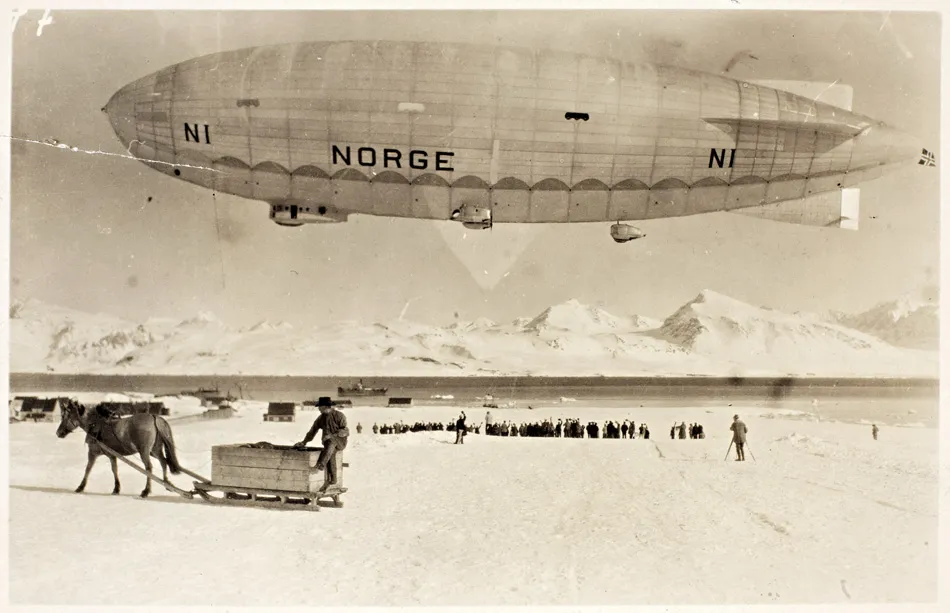
Just after take-off on the 11th of
May 1926 at King's Bay
Nobile was in overall command of the flight operations with others piloting, controlling lift and navigating, they all fed back to Nobile who processed the information and gave directions, flying an airship was very much a multi-person operation. The main danger at this point was of ice building up on the envelope especially when passing through fog which as well as potentially adding a great deal of weight could cause valves and flaps to seize up. The Norge approached the pole at 1.30 a.m. on the 12th of May (at that time of year there is 24 hours of daylight) Riiser-Larsen, the main navigator tracked their progress with the sextant as they approached the exact position of the North Pole (an unmarked area on floating, ever moving sea-ice). Nobile ordered the engines cut off and the Norge drifted slowly and quietly over the area before starting to circle slowly at a altitude of about 100m. Amundsen and Oscar Wisting in the cabin were now the first men to have been to both the North and South poles, they exchanged a quiet handshake. It is likely that this was the first time that the North Pole had actually been reached at all as previous separate claims by Cook and Peary were found to be false and the claim from a few days earlier by Byrd was later found to also be impossible. No landing was made though and no-one stood at the pole as Amundsen and Wisting (in a party of five) had at the South Pole fifteen years earlier.
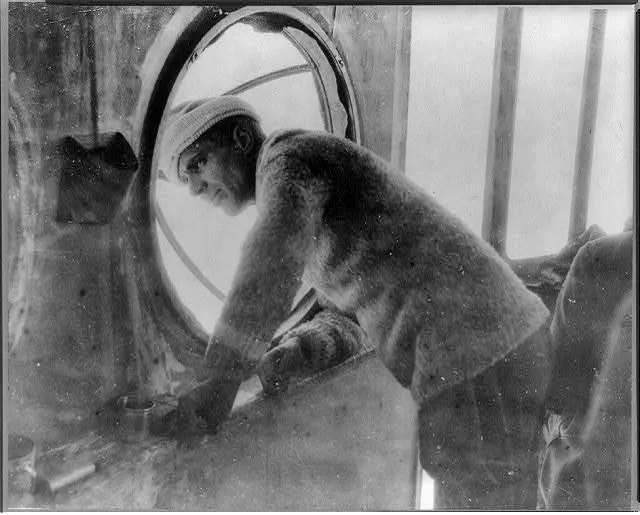 Nobile looks out of the side window
of the forward control car shortly after take off
Nobile looks out of the side window
of the forward control car shortly after take off
Amundsen, Ellsworth and Nobile brought out their national flags attached to sharpened metal spikes to be dropped from the airship and stick in the ice. Nobile had given strict instructions to the others to bring small handkerchief-sized flags to keep the weight down, astonishment followed when he himself brought out an enormous Italian flag carried in a special casket on Mussolini's orders along with a number of other large flags and pennants that were dropped over the side, one of which caught for a while in one of the slowly moving propellers threatening to damage it.
After an hour of circling, the engines were fired up and the Norge set off for Alaska across a completely unknown stretch of ocean where it was hoped that new lands might be found. Fatigue set in as the crew had been awake for many hours and the excitement of reaching the pole was now passed so they took the opportunity to sleep.
Soon they began to pass through patches of fog until eventually they were surrounded by it which reduced visibility to hardly anything and more dangerously began to form sheets of ice on the envelope which increased the weight and then started to break off in chunks and slide down, sometimes hitting the turning propeller blades and firing broken ice pieces into the outer shell. The speed was reduced to try to avoid this risk which could damage a propeller blade or rupture a gas bag, this of course increased the length of the journey. Ice continued to form especially on the bow of the airship pulling it down until ballast was redistributed by the crew to compensate. The radio antenna, a wire trailing from the back of the Norge became coated in ice cutting off all radio contact, updated weather reports could not be received and in the absence of updates from the expedition rescue ships in Alaska were put on alert.
The fog disappeared after some hours and the airship continued over featureless sea-ice until land was spotted which measurements indicated to be the northern coast of Alaska, they had crossed from the pole, over one of the world's last unknown regions and found no new lands. They continued along the coast pushed by a tail wind to Wainright where they saw Amundsen's cabin he had previously lived in and groups of people waving and cheering.
By the fourth day of the flight exhaustion was taking a toll on the crew with most having had little sleep since taking off, at times they nodded off where they stood. The weather started to become more unsettled with gusts of wind that blew them out over the Bering Strait away from the coast. Ice formed on the envelope and had to be knocked off by men standing on the rigging otherwise it might drag them down to the sea below, fog came and went, would they be better flying over or under it? The Norge rose and fell like a plaything in the wind and as it did so, the temperature changed which had an effect on the hydrogen gas in the bags, there was no more ballast and Nobile daren't vent too much gas to control it within the storm for fear of not having enough for lift later on. Eventually control was gained and they started to move back towards the coast, though now this presented the danger of being blown into the mountains. Nobile stuck to a course southwards along the coast trying to avoid the fog, they had little real choice other than go where they were being carried.
Riiser-Larsen wanted to get a sextant reading from the sun and climbed along ladders to get to the bow, Nobile was steering it to get above the fog and when it did so the sun heated the gas chambers which expanded and began to vent gas through automatic pressure valves. Nobile tried to level the airship out, but still it was pointed upwards and rising. After some confused shouting and gesticulations due to language barriers the crew moved forwards along the internal gangplanks shifting their weight to tilt the airship down again, a move that saved the gas bags from rupturing but started the airship on a downwards trajectory through the fog to the ground. In two minutes, the Norge had climbed to 1,650m then plummeted to 180m while being blown inland by the wind. The journey continued to be eventful with headwinds, stormy weather and rather too close proximity to the ground at times, at one point the trailing radio antenna got caught up with some rocks and was pulled off. The crew snatched sleep when they could in chairs or even as they stood.
The roofs of houses appeared and it was agreed to land the Norge even though they knew it wasn't the intended destination of Nome. Landing lines and an anchor were readied and dropped, though before anyone could climb off, a gust of wind pulled the anchor free and pushed the airship towards the shore. Nobile opened the valves to release the hydrogen gas and as the gas bags emptied the Norge began to sag, large pieces of ice were released from where it had encrusted the envelope crashing dangerously to earth, the crew hurriedly slid down ropes to escape the collapse of the great beast. The Norge had come down in a field near to some houses and a small crowd had gathered, the crew were informed they were in the small town of Teller, about 160km north of Nome.
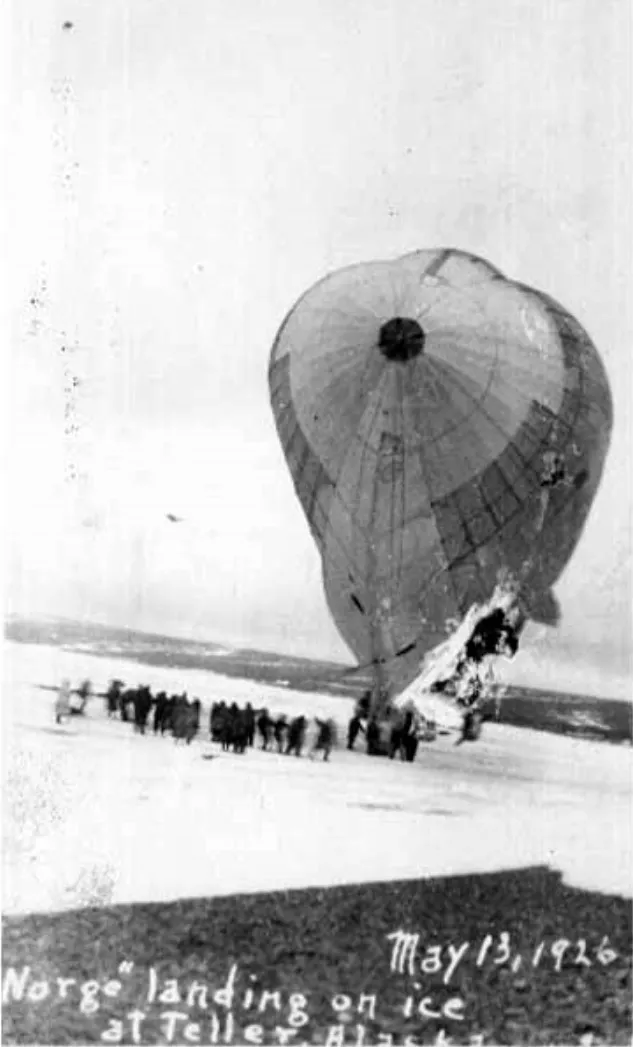 The Norge on landing at Teller, Alaska on the 13th of May 1926.
The Norge on landing at Teller, Alaska on the 13th of May 1926.
The expedition now over, Amundsen, Ellsworth and others headed to Nome by boat to get the story out as the wireless transmitter in Teller wasn't working, Nobile and Riiser-Larsen remained to supervise the packing of the airship. Before Amundsen reached Nome however, the Teller transmitter was repaired and Nobile sent his story. So the story of the expedition began to be told which was increasingly spun into separate threads somewhat at odds with each other. Nobile highlighted the Italian and his own personal contributions and downplayed those of the Norwegians and Americans, this was lapped up by the then fascist state under Mussolini, not only in Italy but also by the large Italian community in the USA. This was entirely against an agreement he had made with Amundsen and the Norwegian Aero Club not to do so without first getting authorization. By the time Amundsen and Ellsworth sent their version to the newspapers, it had become general news already largely reported elsewhere so lacking much of the "first rights" exclusivity and much of the monetary value that arose from this.
The reception in Nome was less positive than anticipated, the town had gone to considerable trouble and expense to receive and anchor the Norge and was widely decorated for the landing and reception of the crew. Amundsen was seen by many to have failed to deliver on his promise to make his first landing there after his flight. When Nobile arrived a few days later he arranged a celebration in honour of the flight to which Amundsen and Ellsworth were not invited.
The publicity machines of both "sides" swung into action, Amundsen and Ellsworth were received as heroes in the eastern USA and in Norway and both were soon lecturing about the trip internationally (this was a common way of recouping the cost of exploration). Nobile who the men had regarded as their employee, appointed to fly the airship according to their requirements was travelling and lecturing separately completely against agreements they had earlier made. Increasingly Nobile claimed that it was the fascist Italian state and himself who were the heroes of the piece with Amundsen and Ellsworth simply following his orders their contribution diminishing the more times he told his story. The Italians on the crew were painted as those who got the job done while the Norwegians largely slept, he even expanded his claims to full initiation and organization of the trip by the Italians.
Such patent lies led to retaliation by Ellsworth who made less than flattering comments about the behaviour and activity of the Italian crew in general and Nobile in particular. It all descended into a murky spat fuelled by nationalistic pride. Ellsworth and Amundsen also fell out with the Norwegian Aero Club who they accused of representing them badly and mismanaging their interests, in particular of failing to secure valuable film rights, and even sponsoring and endorsing a lecture tour of the USA by Nobile. While Amundsen had good reason to be angry at Nobile's betrayal, it didn't go well for anyone concerned to be washing their dirty laundry in public, and took the shine off what really was a remarkable achievement of teamwork by all involved.
Historical pictures from Nasjonalbiblioteket / National Library of Norway, link
Roald Amundsen Books and Video

The South Pole:
Roald Amundsen, the Norwegian Antarctic Expedition, 1910-1912
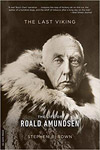
The Last Viking:
The Life of Roald Amundsen

Roald Amundsen's Sled Dogs:
The Sledge Dogs Who Helped Discover the South Pole
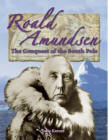
Roald Amundsen
The Quest for the South Pole, ages 9-12

The Amundsen Photographs
discovered in 1986, pictures from three of Amundsen's voyages
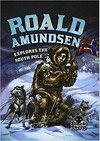
Roald Amundsen Explores the South Pole
ages 7-10


